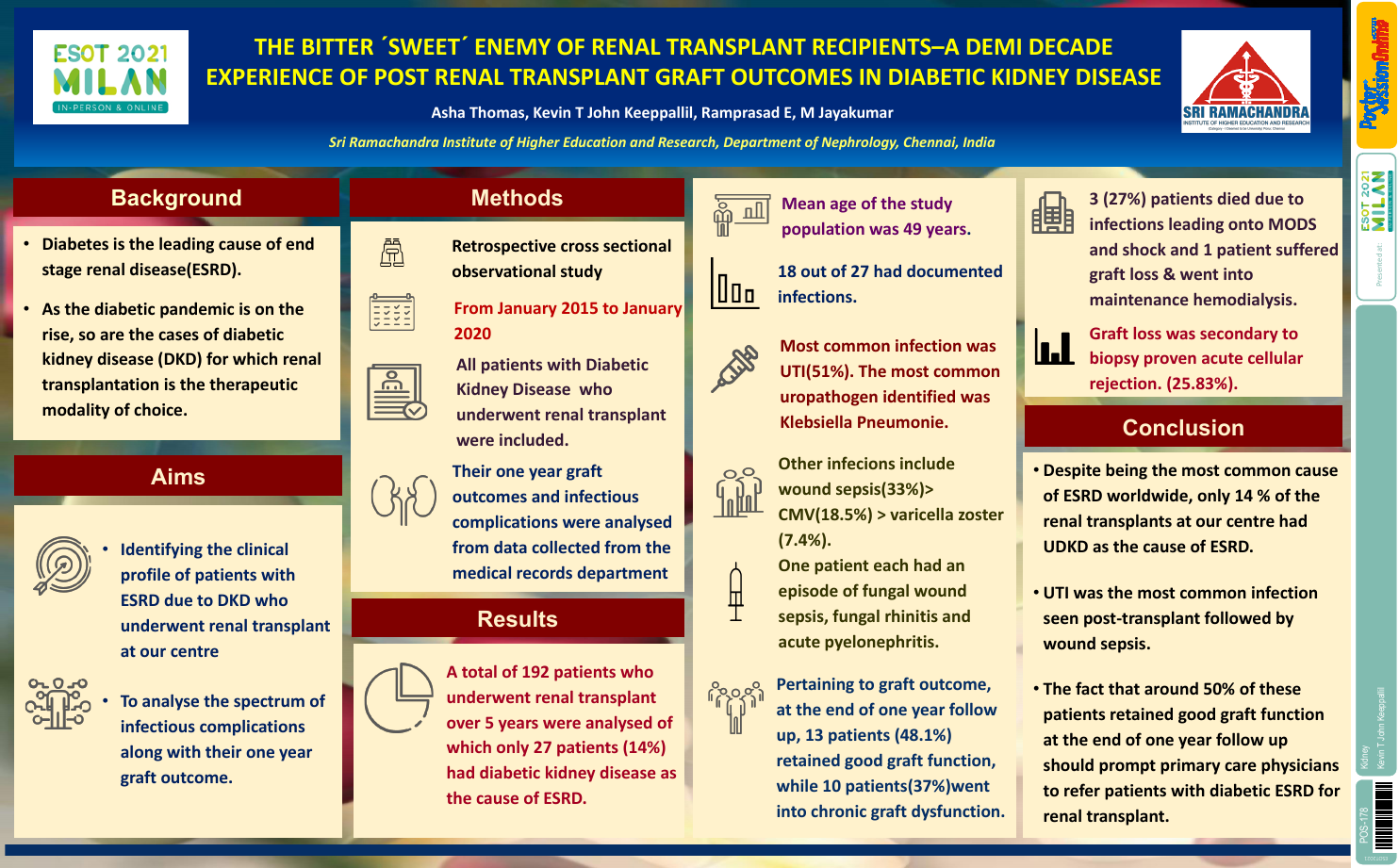
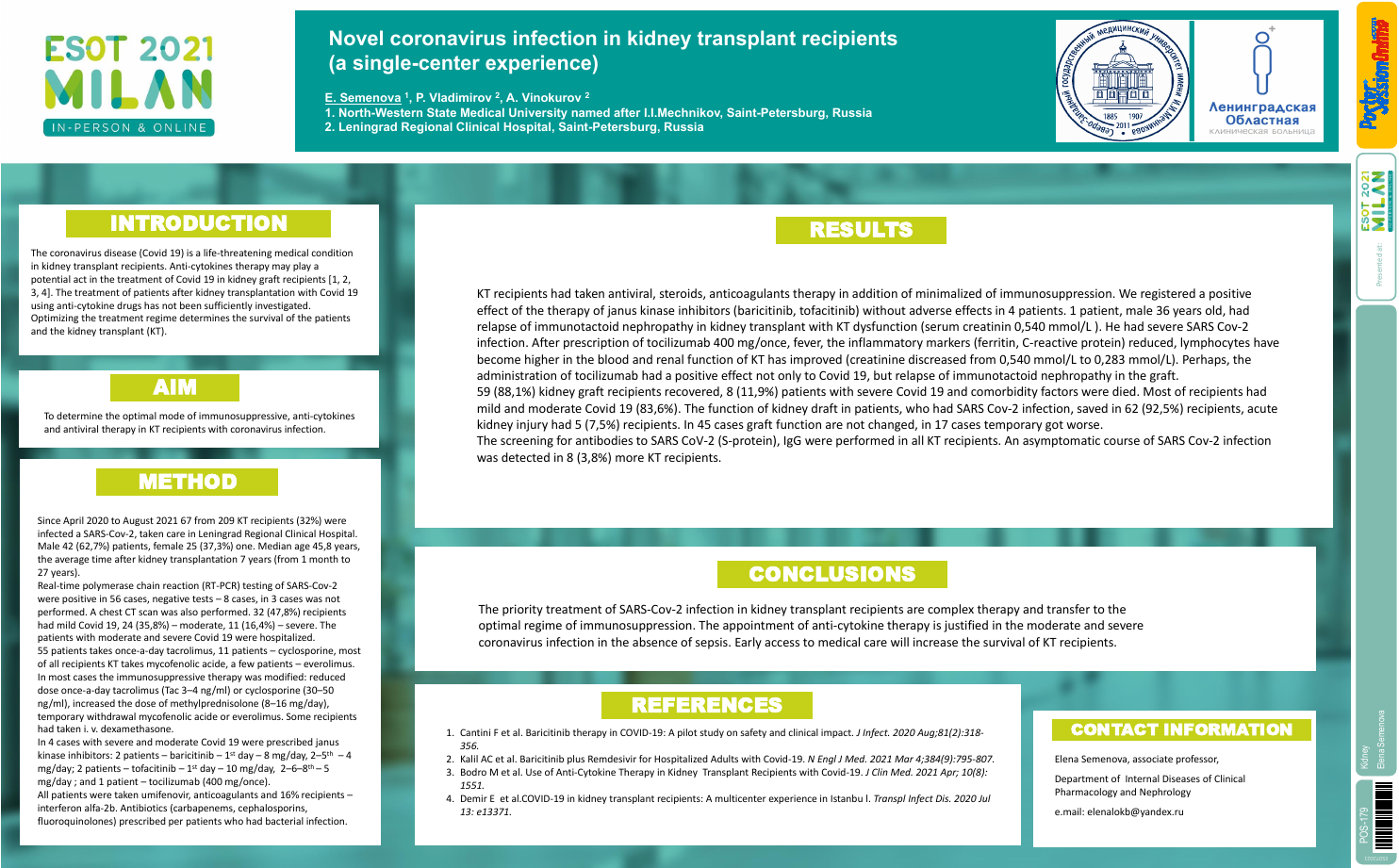
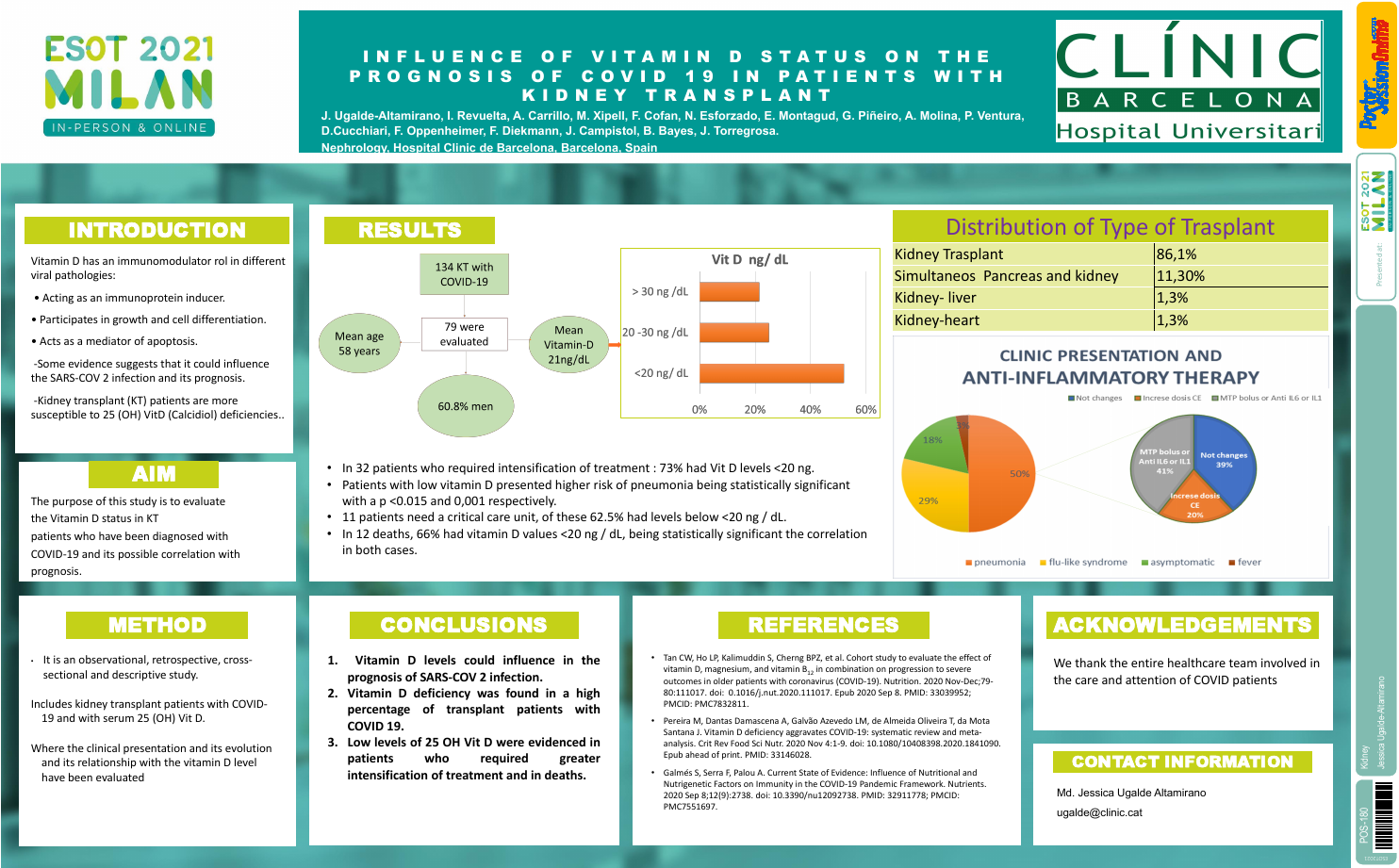
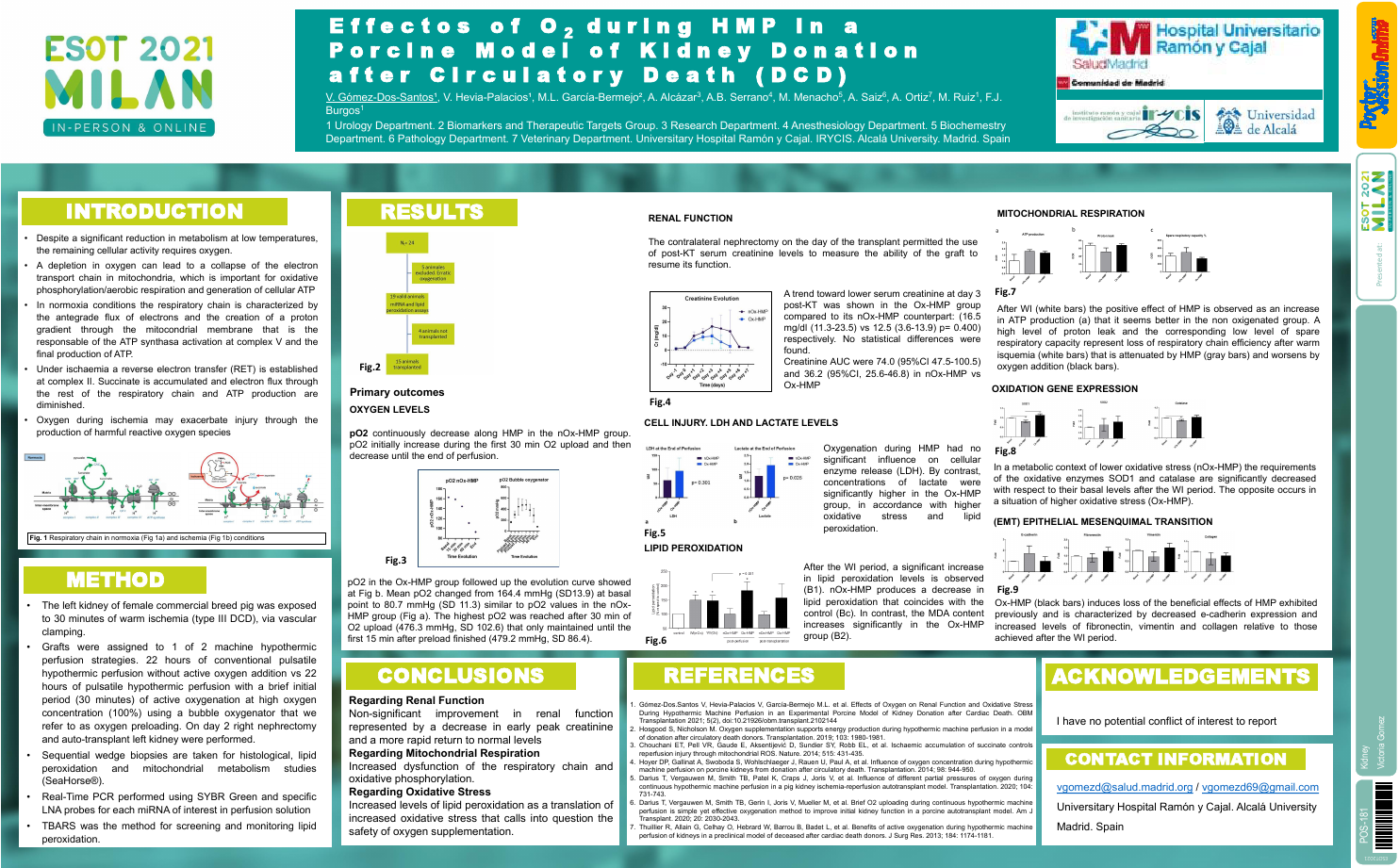
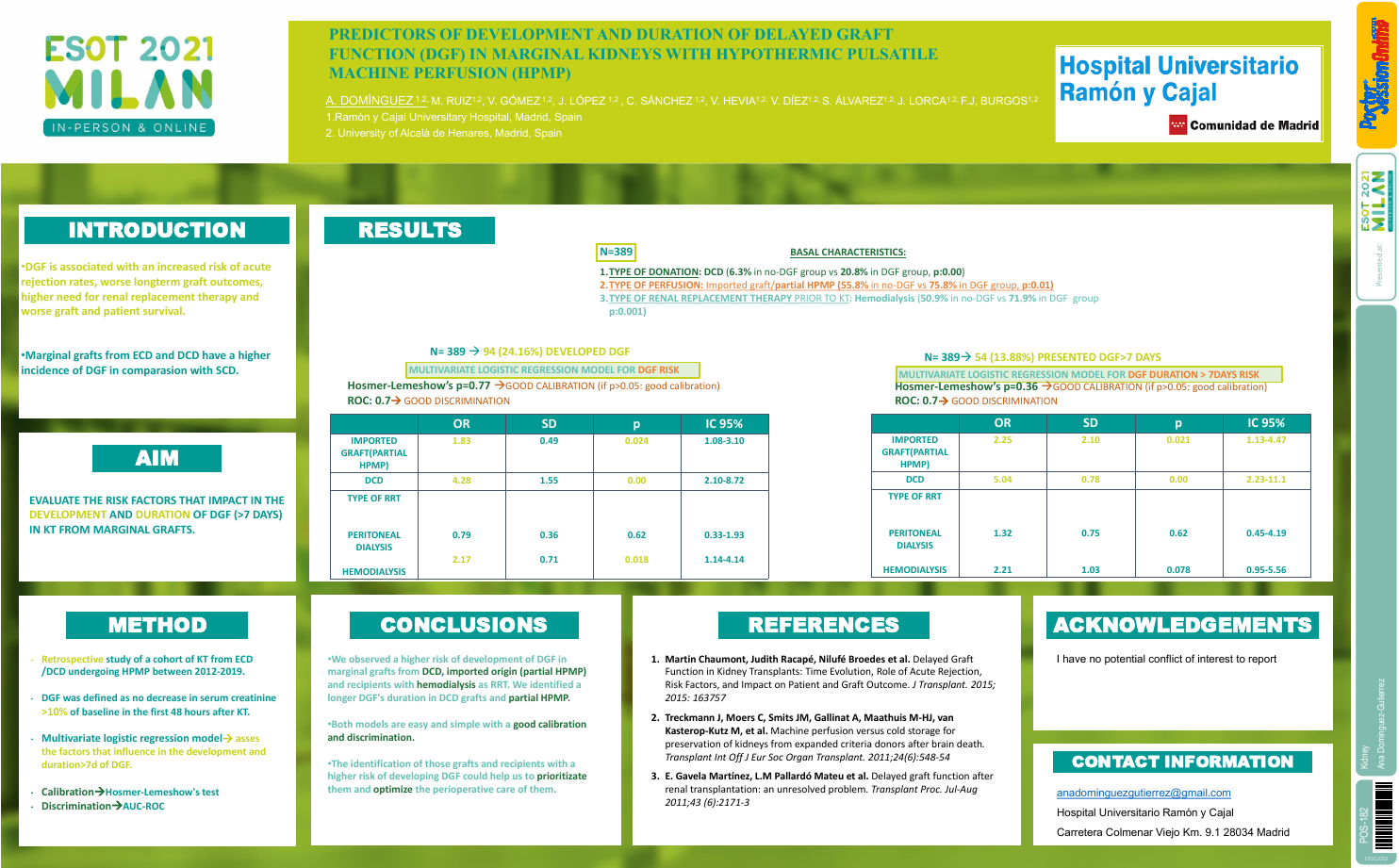
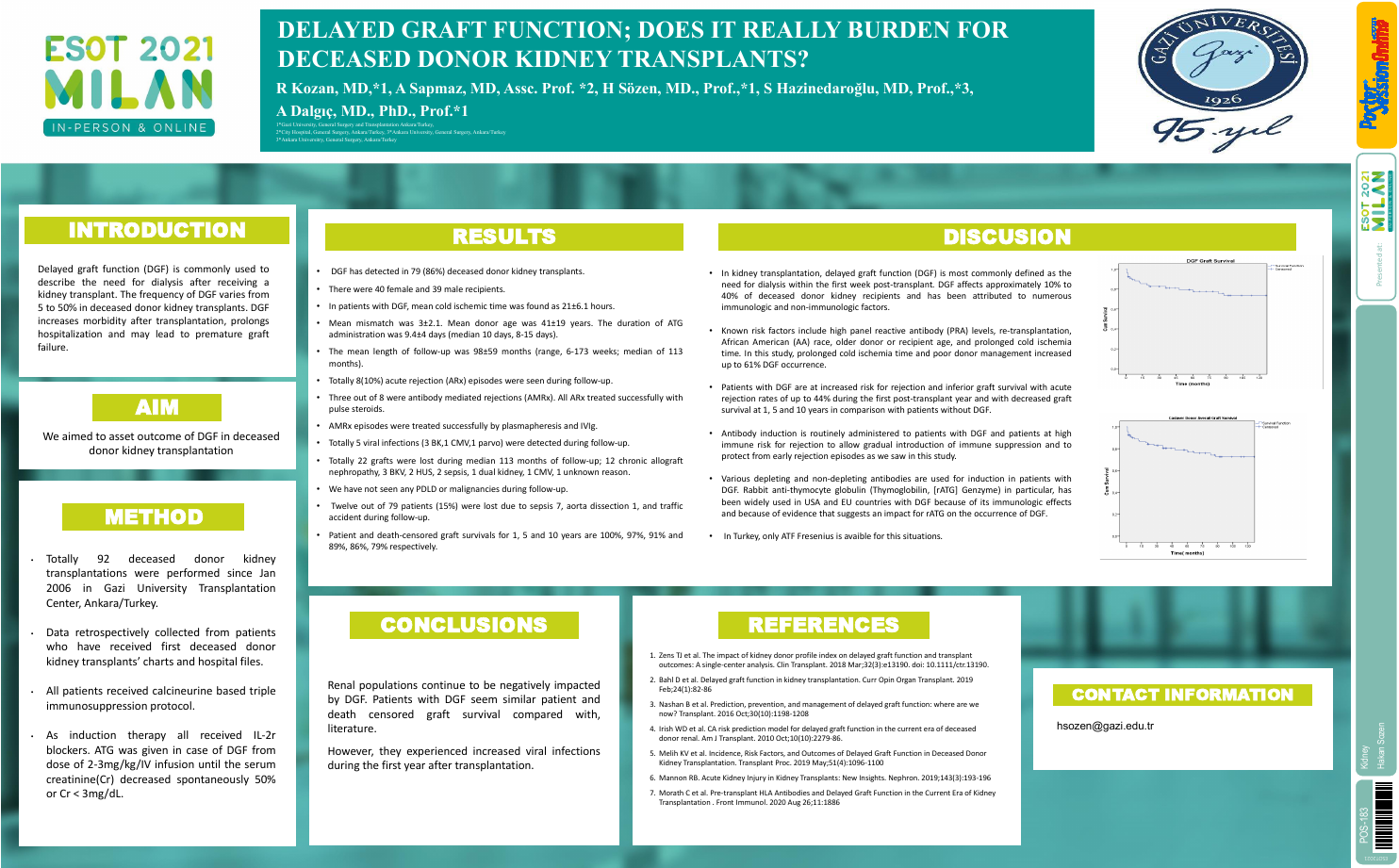
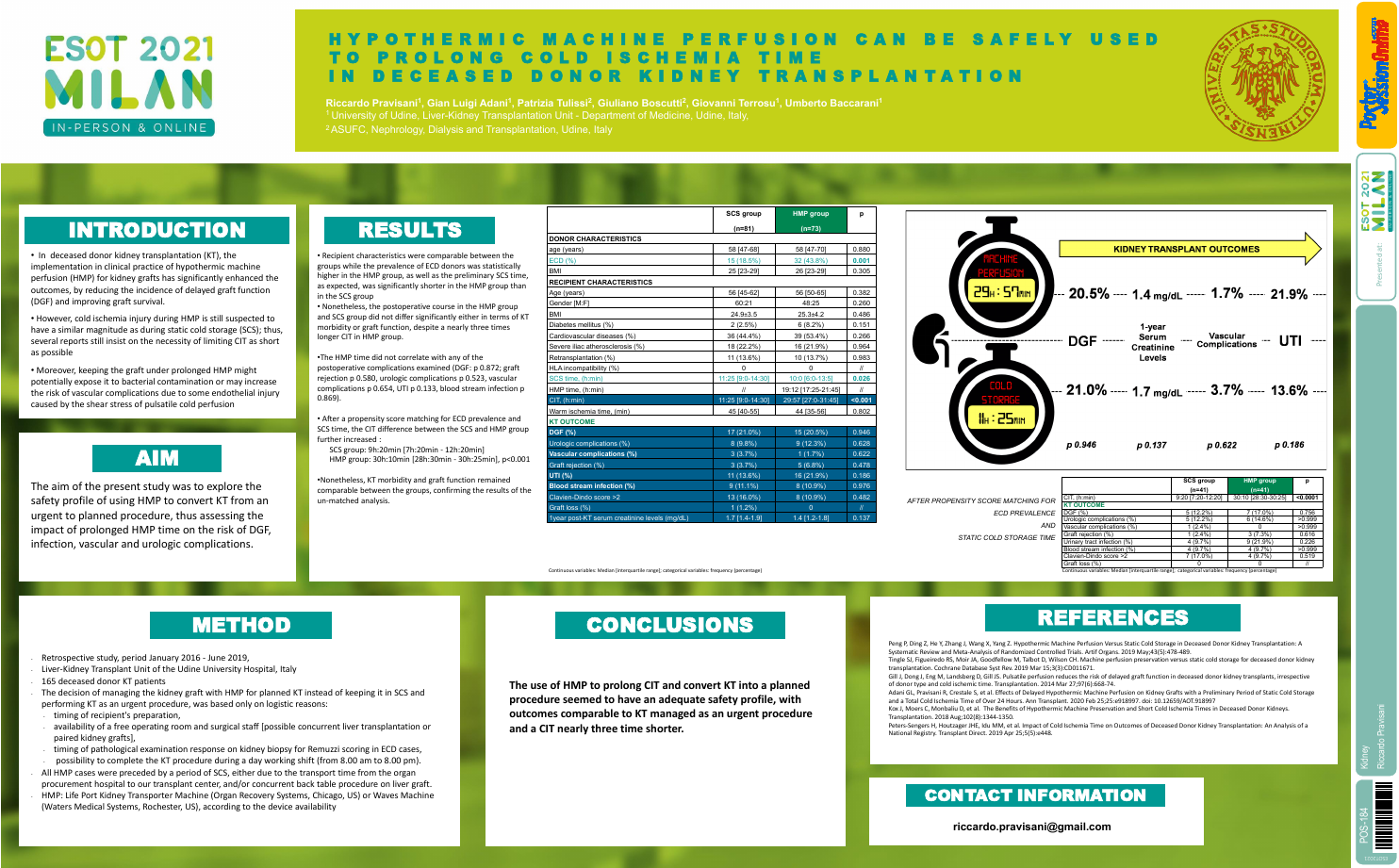
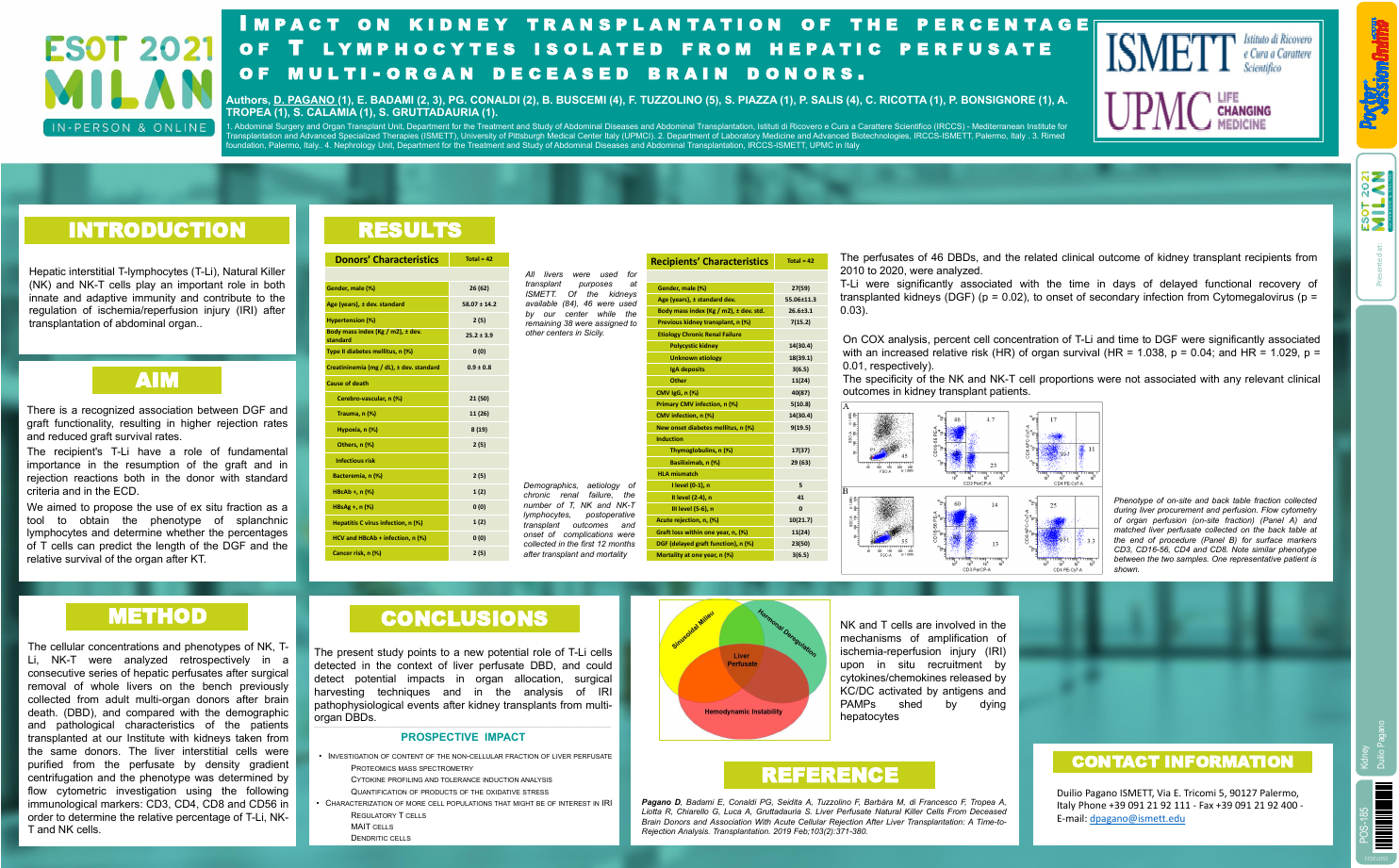
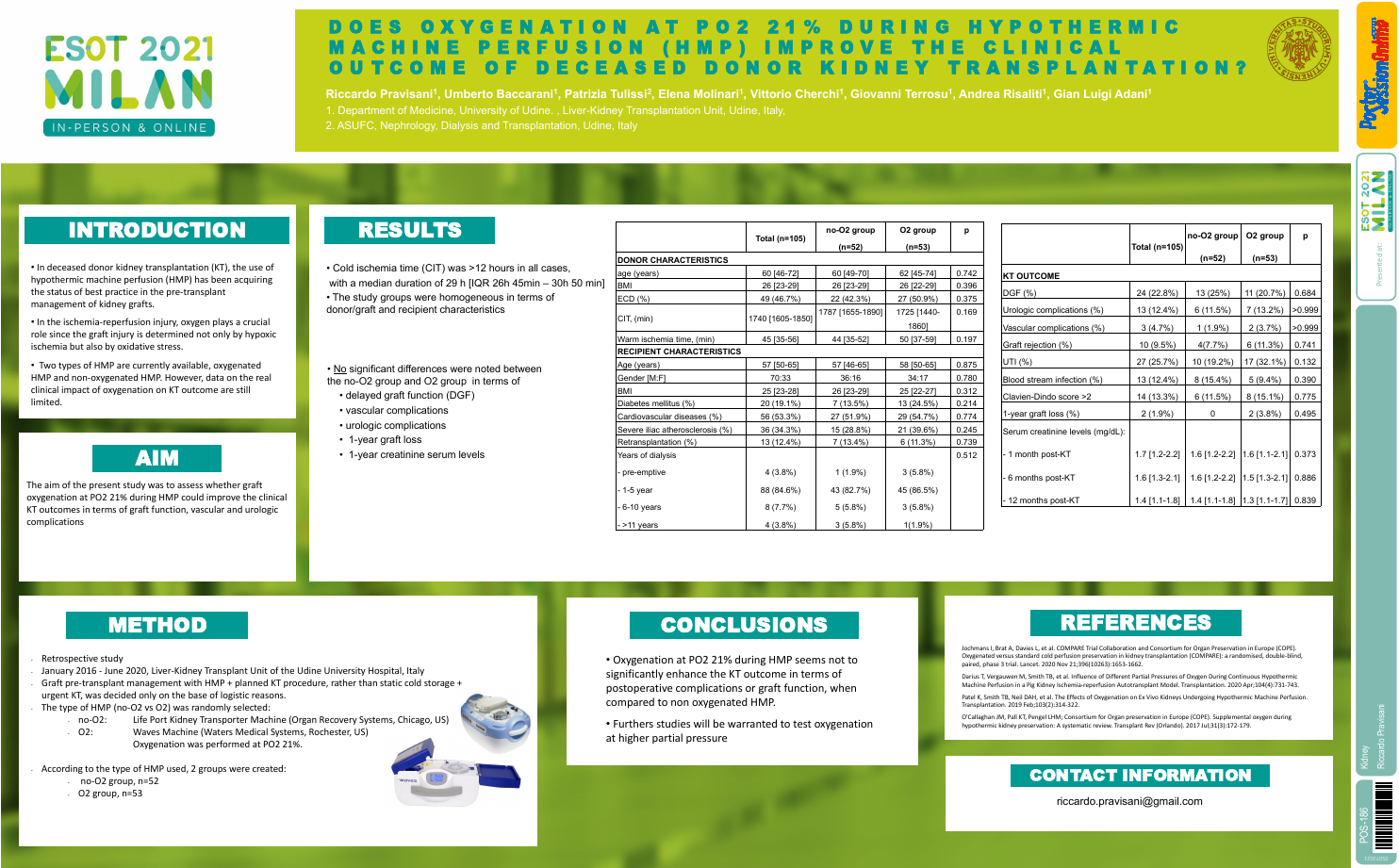
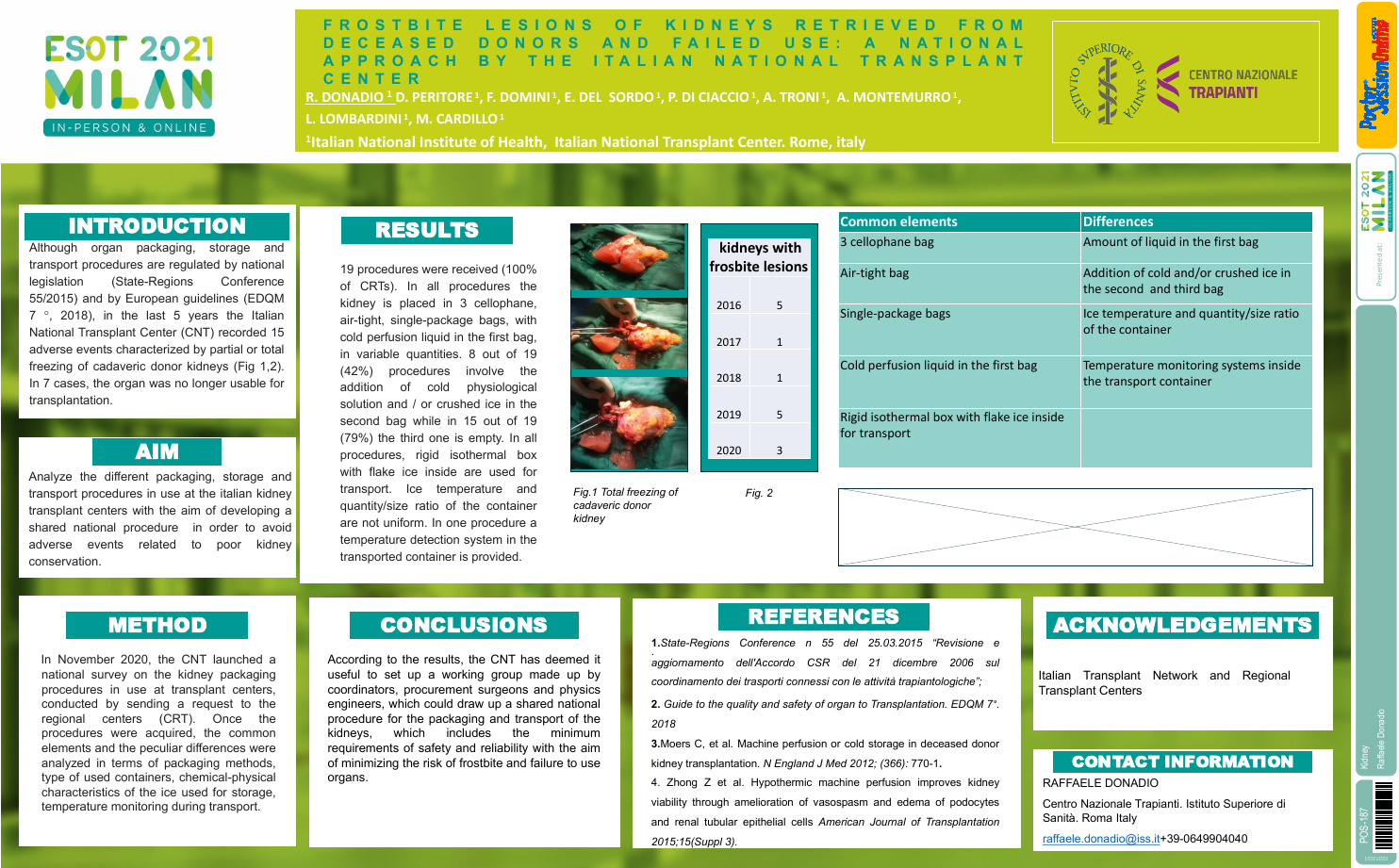
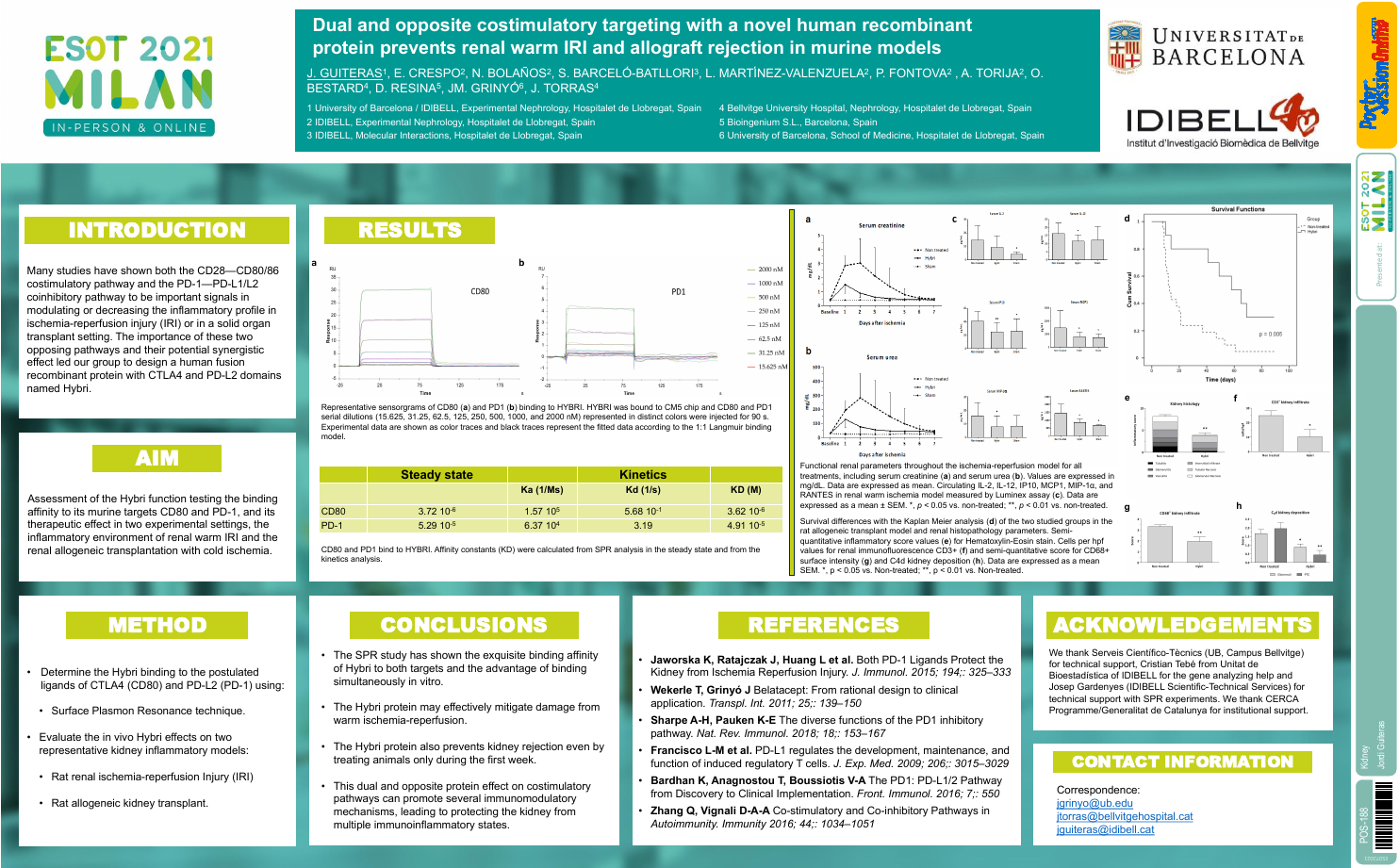
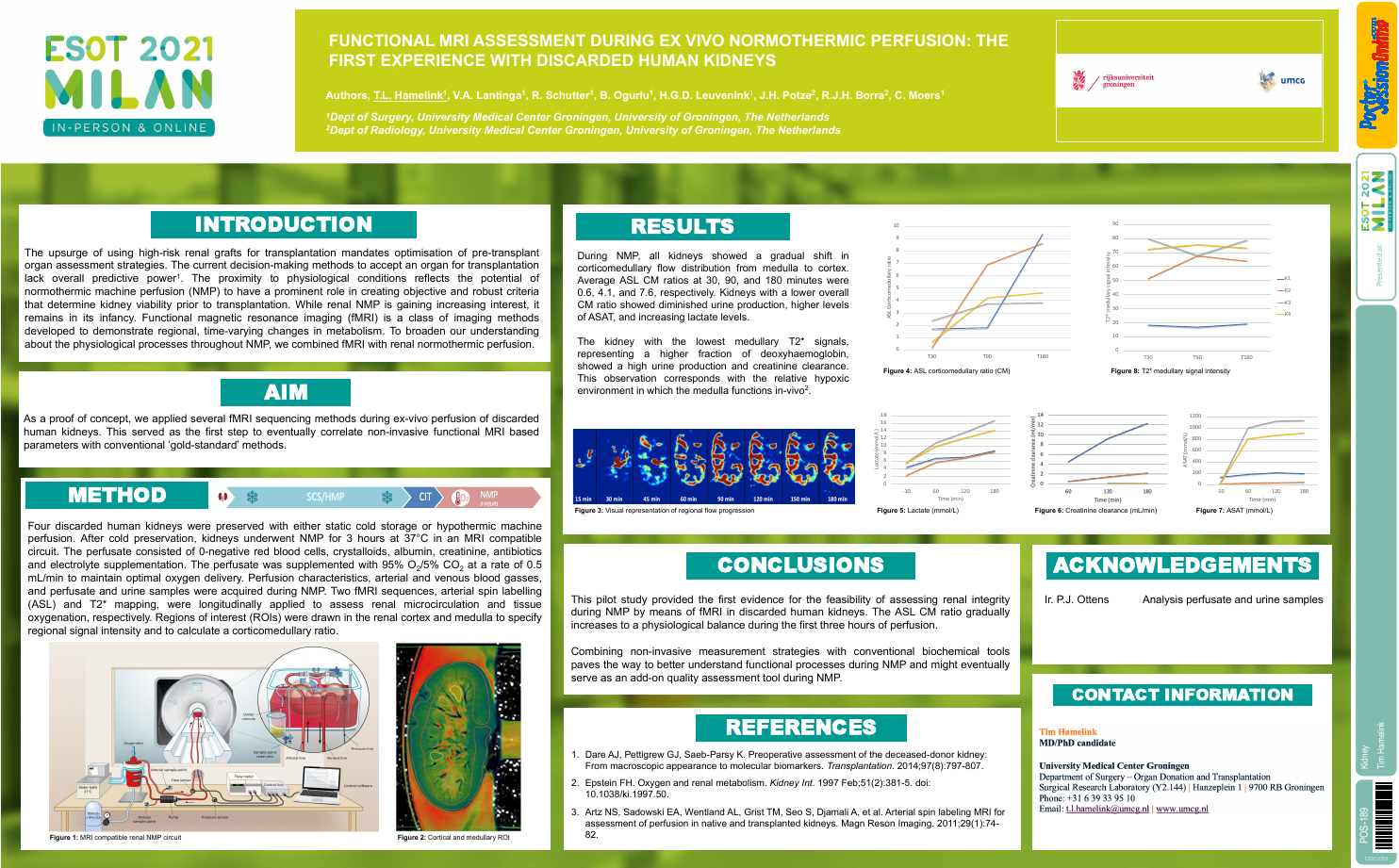
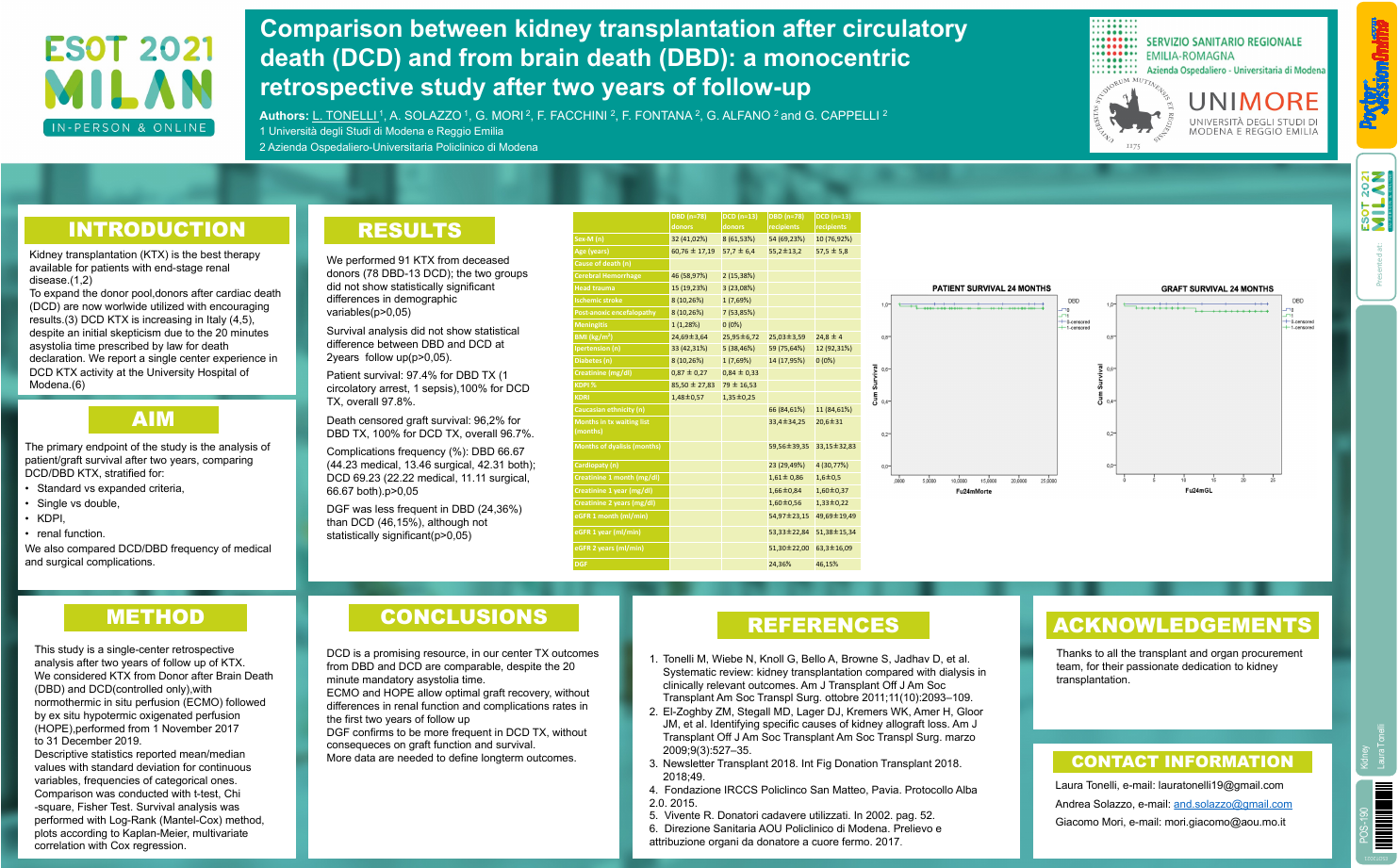
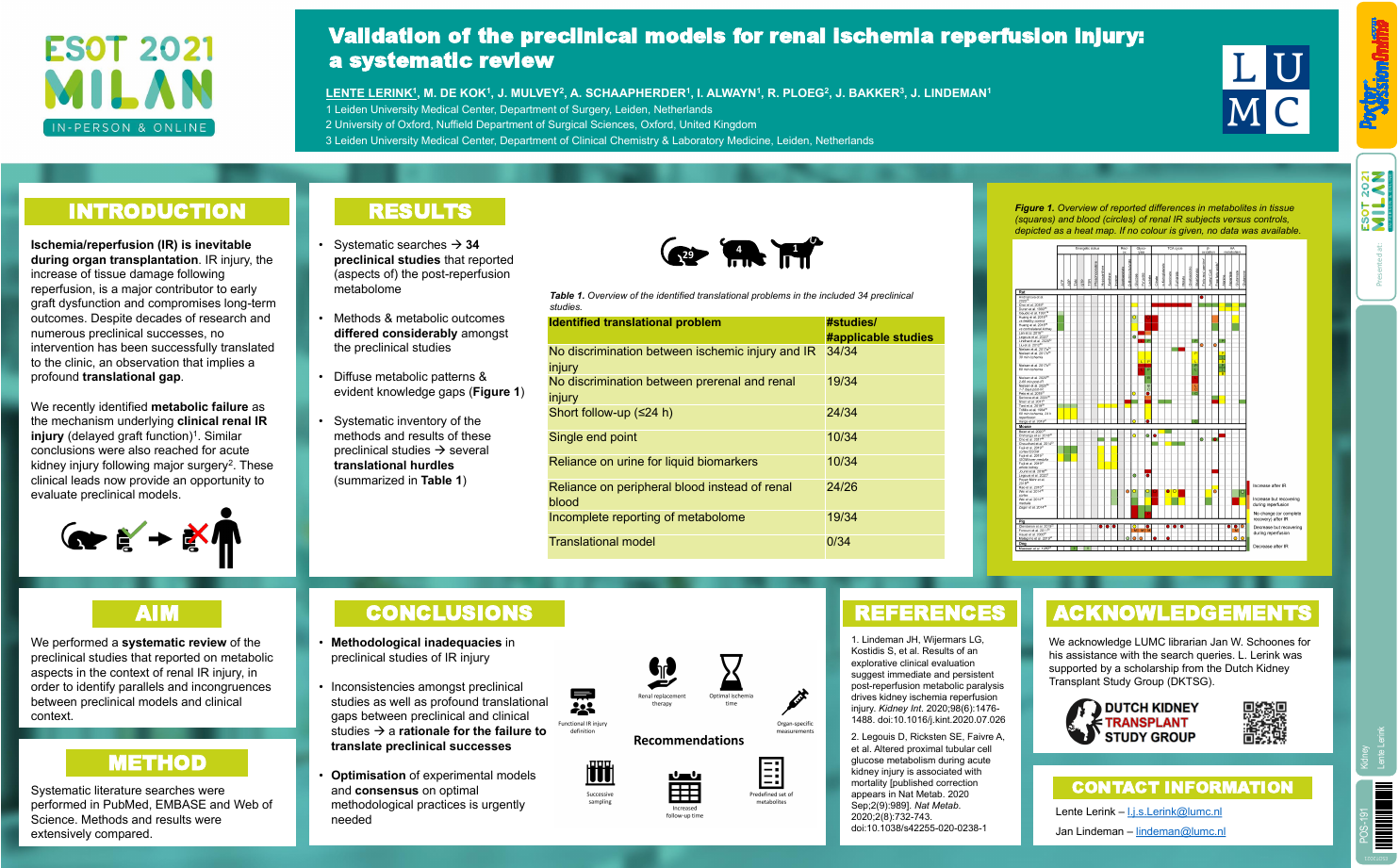
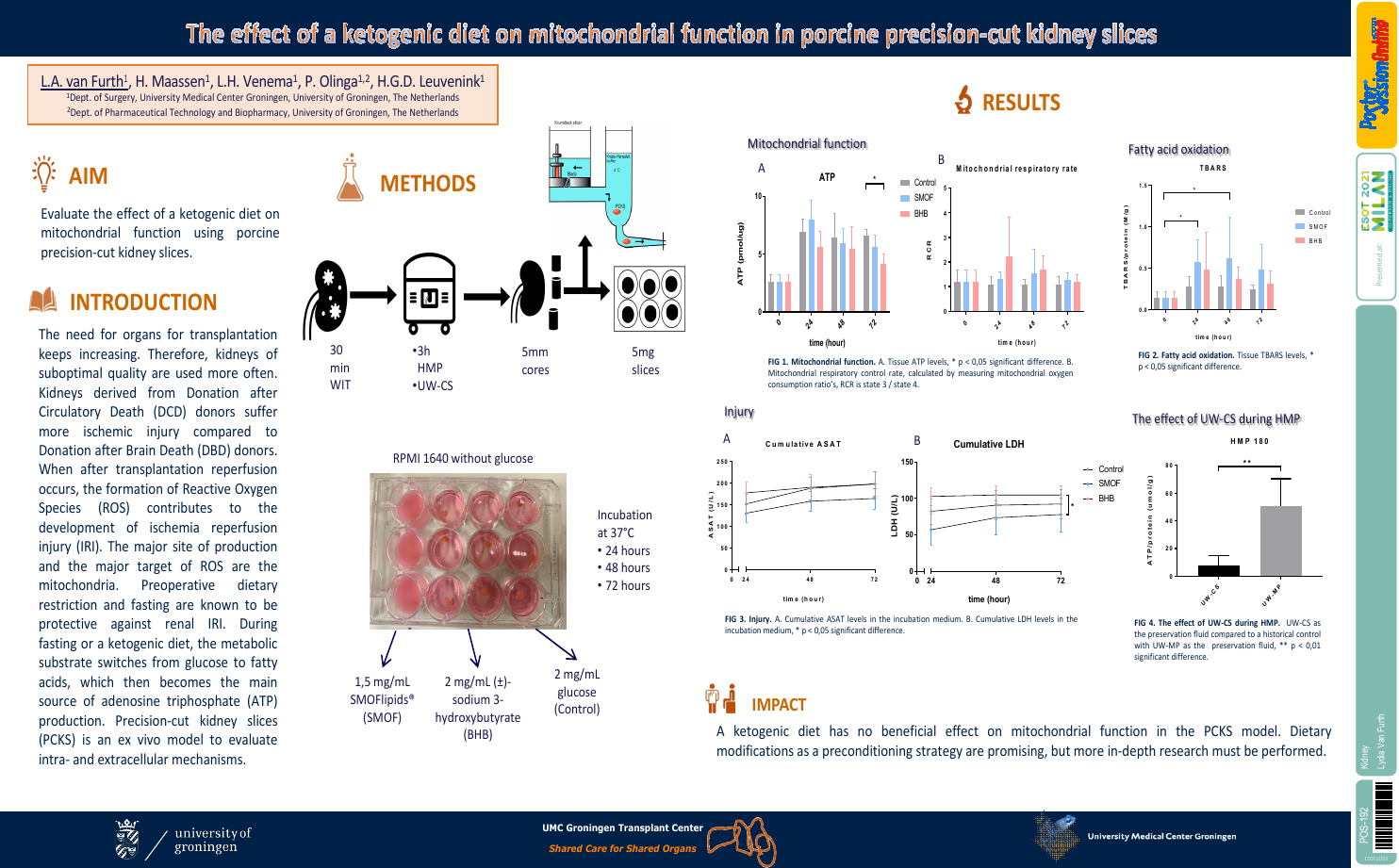
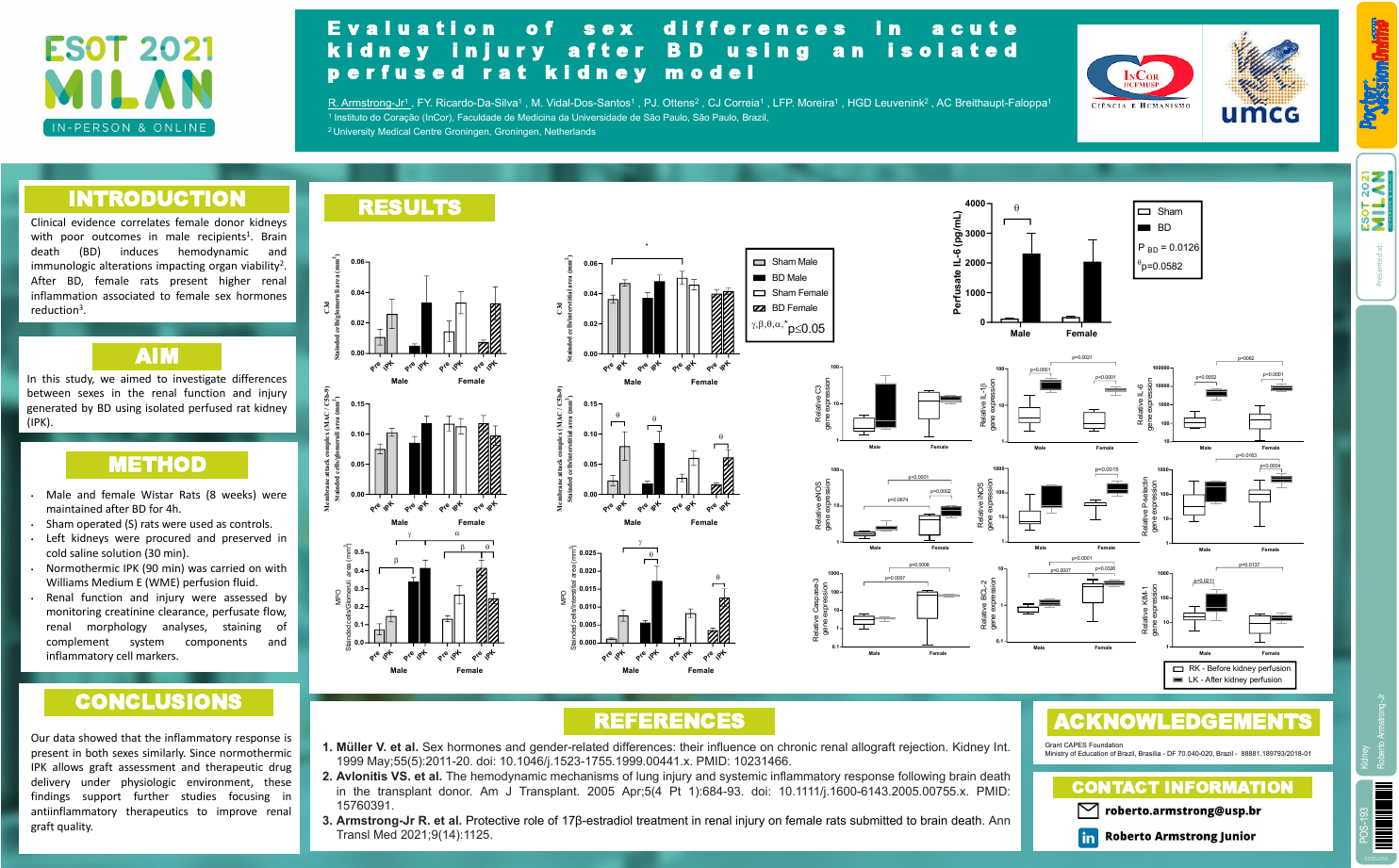
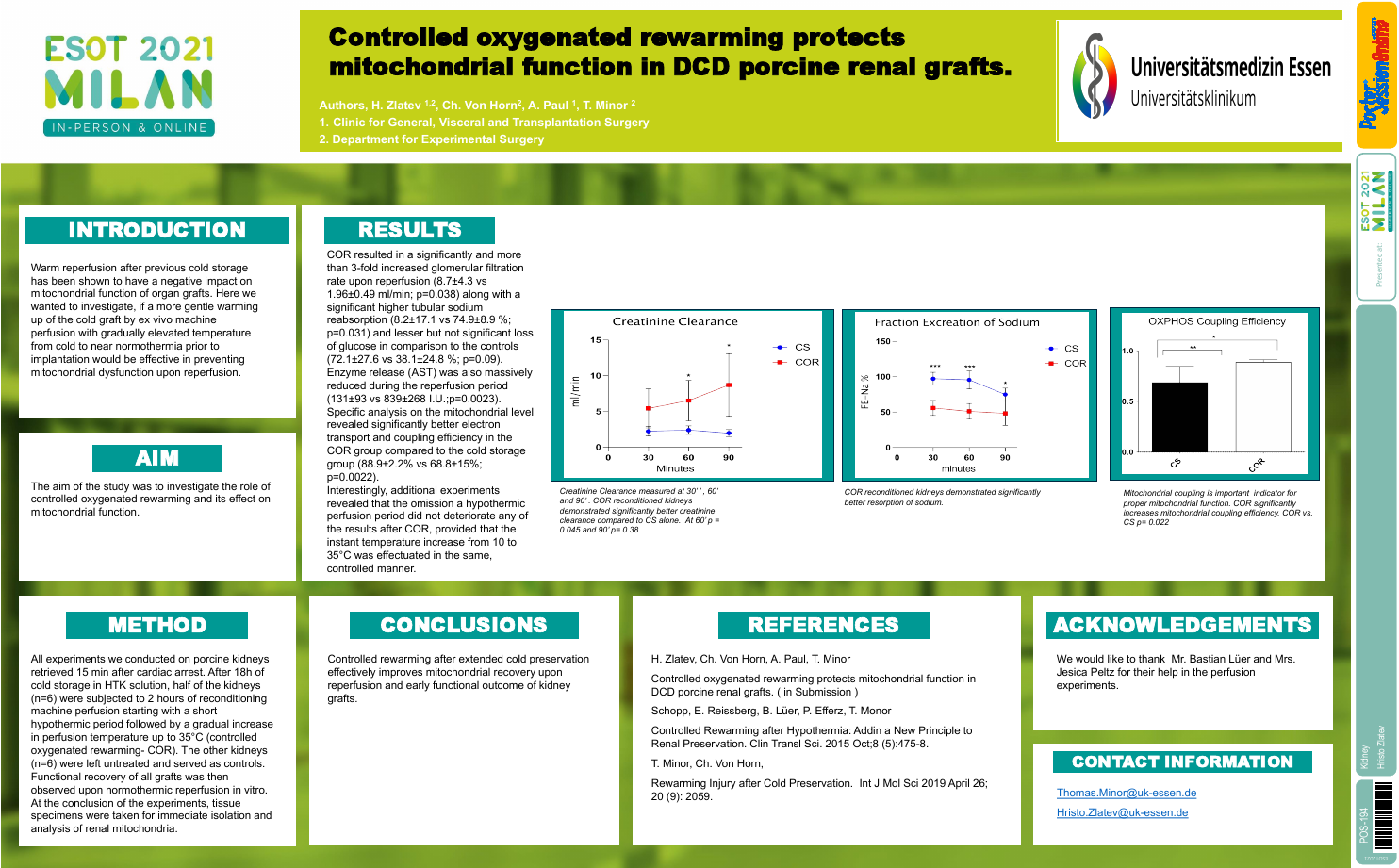
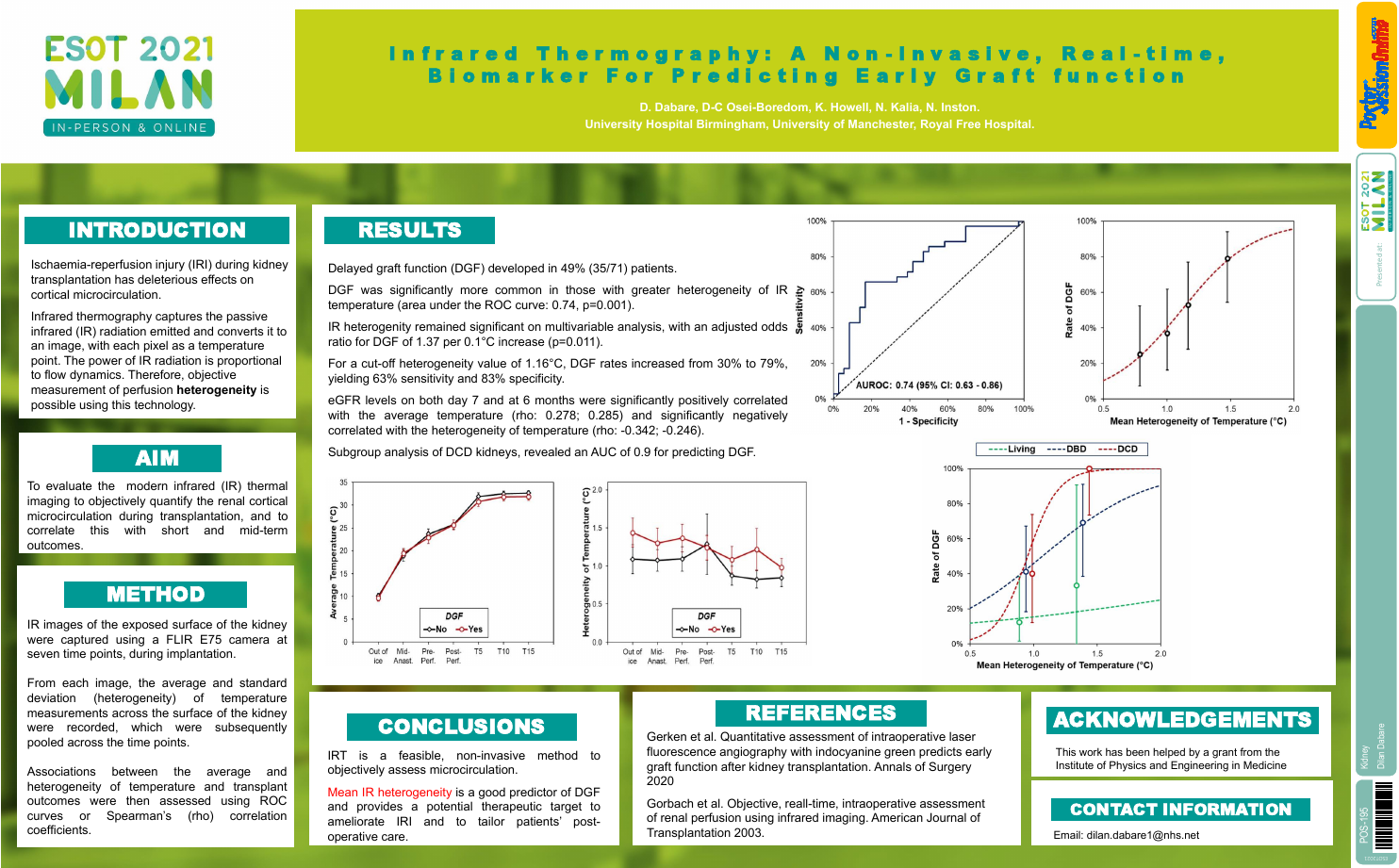
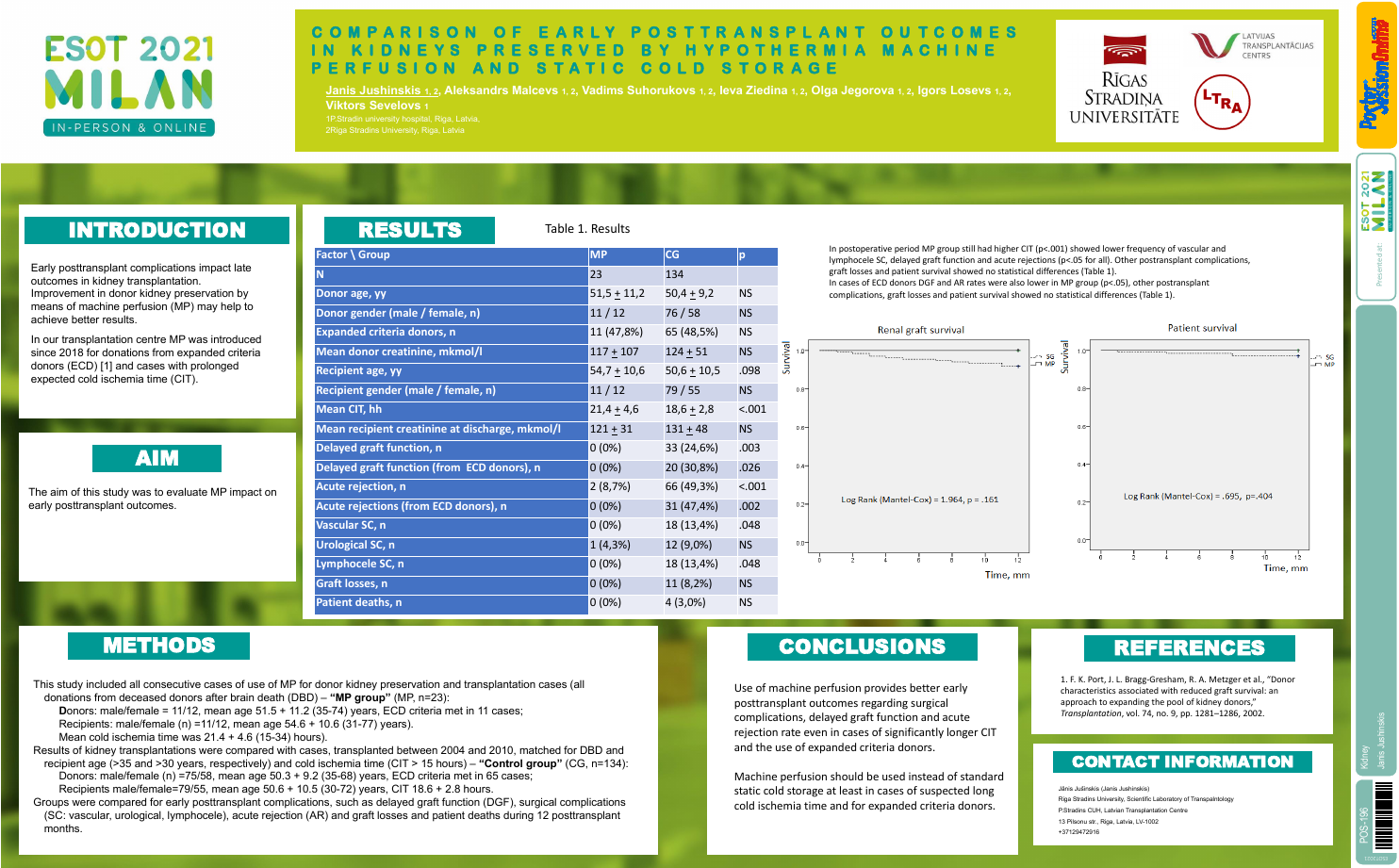
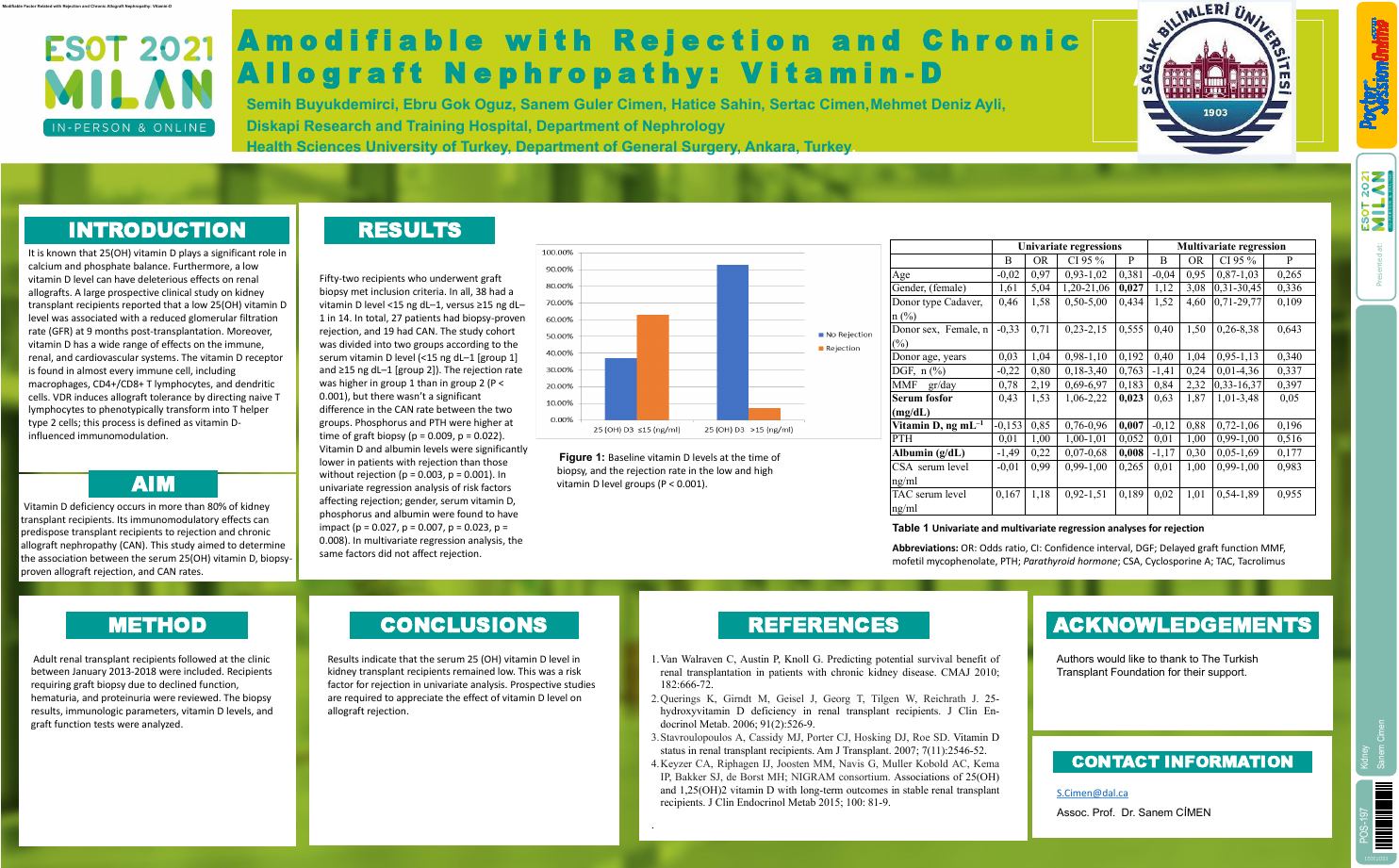
| THE BITTER SWEET ENEMY OF RENAL TRANSPLA.. | Kevin T John Keeppallil .. | Asha ThomasRamprasad EM Jayaku.. | Kidney.. | - - | |
| NOVEL CORONAVIRUS INFECTION IN KIDNEY TR.. | Elena Semenova .. | .. | Kidney.. | - - | |
| INFLUENCE OF VITAMIN D STATUS ON THE PRO.. | Jessica Ugalde-Altamirano .. | .. | Kidney.. | - - | |
| EFFECTS OF OXYGEN DURING HYPOTHERMIC MAC.. | Victoria Gomez .. | .. | Kidney.. | - - | |
| PREDICTORS OF DEVELOPMENT AND DURATION O.. | Ana Dominguez-Gutierrez .. | ANA DOMINGUEZ-GUTIERREZ; MERCE.. | Kidney.. | - - | |
| DELAYED GRAFT FUNCTION; DOES IT REALLY B.. | Hakan Sozen .. | .. | Kidney.. | - - | |
| HYPOTHERMIC MACHINE PERFUSION CAN BE SAF.. | Riccardo Pravisani .. | .. | Kidney.. | - - | |
| IMPACT ON KIDNEY TRANSPLANTATION OF THE .. | Duilio Pagano .. | E. BADAMI, PG. CONALDI, B. BUS.. | Kidney.. | - - | |
| DOES OXYGENATION AT PO2 21 DURING HYPOTH.. | Riccardo Pravisani .. | .. | Kidney.. | - - | |
| FROSTBITE LESIONS OF KIDNEYS RETRIEVED F.. | Raffaele Donadio .. | .. | Kidney.. | - - | |
| DUAL AND OPPOSITE COSTIMULATORY TARGETIN.. | Jordi Guiteras .. | Elena Crespo, Nuria Bolaños, S.. | Kidney.. | - - | |
| FUNCTIONAL MRI ASSESSMENT DURING EX VIVO.. | Tim Hamelink .. | .. | Kidney.. | - - | |
| COMPARISON BETWEEN KIDNEY TRANSPLANTATIO.. | Laura Tonelli .. | Andrea Solazzo, Giacomo Mori.. | Kidney.. | - - | |
| Validation of the preclinical models for.. | Lente Lerink .. | .. | Kidney.. | - - | |
| THE EFFECT OF A KETOGENIC DIET ON MITOCH.. | Lydia Van Furth .. | .. | Kidney.. | - - | |
| EVALUATION OF SEX DIFFERENCES IN ACUTE K.. | Roberto Armstrong-Jr .. | .. | Kidney.. | - - | |
| CONTROLLED OXYGENATED REWARMING PROTECTS.. | Hristo Zlatev .. | .. | Kidney.. | - - | |
| INFRARED THERMAL IMAGING: A NON-INVASIVE.. | Dilan Dabare .. | .. | Kidney.. | - - | |
| COMPARISON OF EARLY POSTTRANSPLANT OUTCO.. | Janis Jushinskis .. | Aleksandrs Malcevs, Vadims Suh.. | Kidney.. | - - | |
| IS VITAMIN D DEFICIENCY RELATED TO REJEC.. | Sanem Cimen .. | .. | Kidney.. | - - | |
Abstract
Thunderstorm-related asthma in patients sensitised to olea europaea pollen: twenty emergency department visits for asthmatic symptoms in one single day Losappio, Laura1; Heffler, Enrico2; Falco, Antonio1; Contento, Francesco1; Cannito, Cosimo1; Rolla, Giovanni2 1"Dimiccoli" Hospital, Emergency Department, Barletta, Italy; 2University of Torino - AO Mauriziano "Umberto I", Allergy and Clinical Immunology, Torino, Italy
Background: Associations between thunderstorm and asthma morbidity have been reported in several countries. Common to all epidemics of thunderstorm-related asthma is a significant increase in atmospheric allergen load during and immediately after a thunderstorm. Sensitization to Alternaria species or to grass and parietaria pollens has been suggested to play a key role in thunderstorm-related asthma. The only reported event of thunderstorm-related asthma in Mediterranean area was attributed to sensitization to parietaria pollen.
Method: here we describe a series of 20 patients who presented to Emergency Department in Barletta (94,000 inhabitants), Puglia (Italy) for sudden and severe asthmatic symptoms between May 27th and 28th 2010 (from15:36 to 5:02), immediately after a violent thunderstorm which occurred following a very hot morning (mean temperature: 29°C). All the patients have been subsequently visited by an allergist and underwent allergological work-up which included skin prick tests and a careful clinical history. Local pollen counts were available.
Result: Between May 10th and June 10th 2010, 86 Emergency Department asthma visits were recorded, 20 of them during the study day. Patients' mean age was 44.25 +/- 18.5 years (range: 9-81), 8/20 females, 2 smokers, 16 with a previous history of known respiratory allergy. Only two patients regularly took anti-asthma drugs. All 20 patients were sensitized to Olea europaea pollen, 7 of whom were monosensitized. Ten patients were sensitized to grass, 7 to parietaria, 5 to compositae, 5 to cypress, 5 to house dust mites, 3 to dog and 1 to cat danders. No patient was sensitized to Alternaria. Mean pollen count was 17 granules/m3 for Olea europaea, 6 granules/m3 for grass pollen.
Conclusion: This is, in our knowledge, the second epidemic of thunderstorm related asthma described in Mediterranean area and the first one in which sensitization to Olea europaea played a key-role. In conclusion, our report indicates that thunderstorm asthma may involve different allergens (not only fungal spores and grass or parietaria pollen) in different geographic areas, depending on the seasonality of thunderstorms and allergenic pollen.